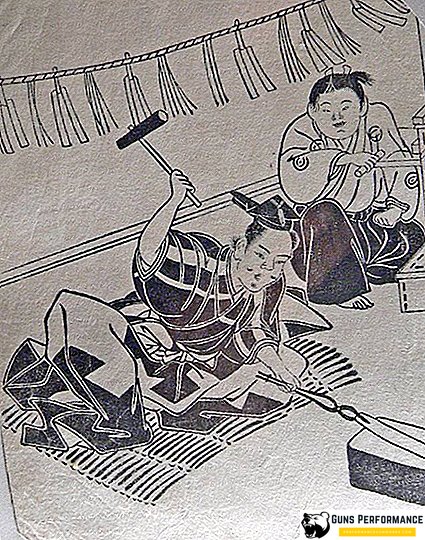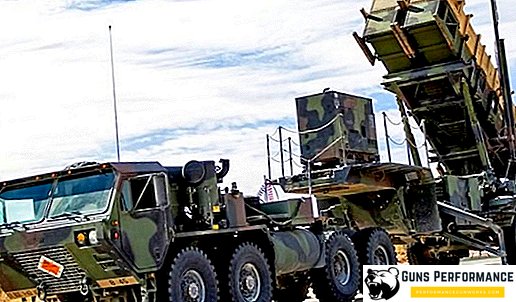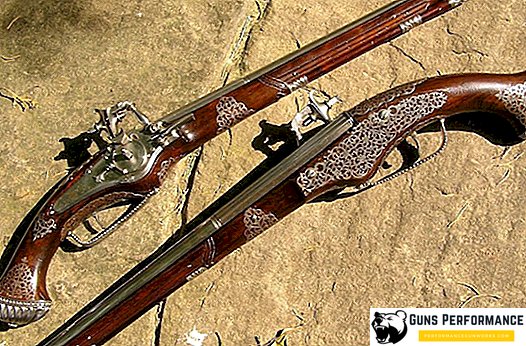It is difficult to name an invention that would have such a significant impact on the development of our civilization, as the sword can boast. It can not be regarded as a banal murder weapon, the sword has always been something big. In different historical periods, this weapon was a symbol of status, belonging to a military caste or a noble class. The evolution of the sword as a weapon is inextricably linked with the development of metallurgy, materials science, chemistry and mining.
In almost all historical periods, the sword was the weapon of the elite. And the point here is not so much in the status of this weapon, but in its high cost and complexity of producing high-quality blades. Making a sword that could be entrusted with your life in battle was not just a laborious process, but a real art. And the blacksmiths involved in this work can be safely compared with virtuoso musicians. It is not without reason that from ancient times different peoples have traditions about outstanding swords with special properties made by real blacksmith masters.
The price even of an average blade could reach the value of a small peasant farm. Products of famous masters cost even more. For this reason, the most common type of cold arms of the era of Antiquity and the Middle Ages is a spear, but not a sword.
Over the centuries, developed metallurgical centers have been formed in different regions of the world, whose products were known far beyond their borders. They existed in Europe, the Middle East, India, China and Japan. The work of the blacksmith was honored and very well paid.

In Japan, the Kaji (this is the blacksmith’s gunsmith, the “master of swords”) was on a par with the samurai in the public hierarchy. Unheard of for this country. The craftsmen, who, in theory, should be blacksmiths, were even lower than the peasants in the Japanese table of ranks. Moreover, the samurai sometimes did not disdain themselves to take up the blacksmith's hammer. To show how respected Japan was the labor of a gunsmith, one fact can be cited. Emperor Gotoba (reigned in the 12th century) declared that making a Japanese sword was a work that even princes could do, without diminishing their dignity. Gotoba himself was not averse to working around the hearth, there are a few blades that he made with his own hands.
Today, the media writes a lot about the skills of Japanese blacksmiths and the quality of steel that was used to create a traditional katana. Yes, indeed, making a samurai sword required tremendous skill and deep knowledge, but you can responsibly say that European smiths were in no way inferior to their Japanese counterparts. Although the hardness and strength of the katana are legendary, but the manufacture of the Japanese sword is not fundamentally different from the process of forging European blades.
Man began to use metals for the manufacture of cold arms in the V millennium BC. At first it was copper, which bronze replaced rather quickly, a strong alloy of copper with tin or arsenic.

By the way, the last component of bronze is very poisonous and often turned ancient blacksmiths and metallurgists into cripples, which is reflected in legends. For example, Hephaestus, the Greek god of fire and the patron of blacksmithing, was lame; in Slavic myths, blacksmiths are also often portrayed as crippled.
The Iron Age began at the end of II - the beginning of the I millennium BC. Although bronze weapons have been used for many hundreds of years. In the XII century BC. e. Wrought iron has already been used to make weapons and tools in the Caucasus, in India and Anatolia. Around the VIII century BC. e. welded iron appeared in Europe, rather quickly a new technology spread across the continent. The fact is that the number of copper and tin deposits in Europe is relatively small, but the iron reserves are significant. In Japan, the Iron Age began only in the VII century of the new era.
Making a sword. From ore to cris
For a very long time, the technology of obtaining and processing iron remained practically in one place, they could not adequately meet the ever-growing demand for this metal, therefore iron products were low and they were expensive. And the quality of tools and weapons made from this metal was extremely low. Surprisingly, for almost three thousand years, metallurgy has not undergone any fundamental changes.
Before proceeding to the description of the process of manufacturing cold weapons in antiquity, we should give several definitions related to metallurgy.
Steel is an alloy of iron with other chemical elements, primarily with carbon. It defines the basic properties of steel: a large amount of carbon in steel ensures its high hardness and strength, while reducing the ductility of the metal.

The main way of producing iron in the era of Antiquity and in the Middle Ages (before the XIII century) was the cheese-making process, so named because unheated ("raw") air was blown into the furnace. Forging was the main method of processing the obtained iron and steel. The cheese-making process was very inefficient, most of the iron from the ore went along with the slag. In addition, the raw materials obtained were not of high quality and were very heterogeneous.
Iron production from ore occurred in a cheese-burning furnace (a cheese-burning horn or a domnitse), which had a shape resembling a truncated cone, from 1 to 2 meters high and 60-80 cm in diameter. This furnace was made of refractory bricks or stone, coated with clay on top, which then burned. A pipe for air supply led to the furnace, it was injected with the help of bellows, and in the lower part of the house there was a hole for removal of slags. A large amount of ore, coal and fluxes was loaded into the furnace.
Later, water mills were used to supply air to the furnace. In the 13th century, more sophisticated furnaces appeared - plasters, and then blauofenes (15th century). Their performance was much higher. The real breakthrough in metallurgy took place only at the beginning of the 16th century, when the conversion process was opened, during which high-quality steel was obtained from ore.
Charcoal served as fuel for the cheese-making process. Coal was not used due to the large amount of impurities harmful to iron that it contains. Coke was learned only in the 18th century.
In a cheese-burning furnace, several processes take place at once: the waste rock is separated from the ore and leaves as slags, and the iron oxides are reduced by reacting with carbon monoxide and carbon. It fuses and forms the so-called crits. It consists of cast iron. After receiving the crinkles, it is broken up into small pieces and sorted by hardness, then they work with each fraction separately.
Today, cast iron is the most important product of the steel industry, it used to be otherwise. It is not amenable to forging, therefore, in antiquity, cast iron was considered a useless production waste ("pig iron"), unsuitable for further use. He significantly reduced the amount of raw materials obtained during smelting. They tried to use cast iron: in Europe, cannonballs were made of it, and in India, coffins, but the quality of these products left much to be desired.
From iron to steel. Forging a sword
The iron obtained in the cheese-burning furnace was distinguished by extreme heterogeneity and low quality. It was necessary to make a lot of effort to turn it into a strong and deadly blade. Forging a sword involved several processes at once:
- cleaning iron and steel;
- welding different layers of steel;
- blade making;
- heat treatment products.
After that, the blacksmith needed to make a crosspiece, a head, a sword hilt, and also to make a sheath for it.
Naturally, at present, the cheese-blowing process is not used in industry for the production of iron and steel. However, the forces of enthusiasts and fans of old cold weapons, he was recreated to the smallest details. Today, this sword fabrication technology is used to create "authentic" historical weapons.

The kiln obtained in the furnace consists of low carbon iron (0-0.3% carbon content), a metal with a carbon content of 0.3-0.6% and a high carbon fraction (from 0.6 to 1.6% and higher). Iron, which is low in carbon, is distinguished by high ductility, but it is very soft, the higher the carbon content in the metal, the greater its strength and hardness, but at the same time the steel becomes more fragile.
To give the desired properties of the metal, the blacksmith can either saturate the steel with carbon, or else burn its excess. The process of saturation of the metal with carbon is called cementation.
The blacksmiths of the past had a serious problem. If you make a sword from high carbon steel, it will be durable and keep a good sharpening, but at the same time too fragile, the weapon of steel with low carbon content will not be able to perform its functions at all. The blade must be both solid and elastic. This was the key problem that had been confronted by gunsmiths for hundreds of years.
There is a description of the use of long swords by the Celts, made by the Roman historian Polybios. According to him, the barbarian swords were made of such soft iron that they became dull and bent after each decisive blow. From time to time, Celtic warriors had to correct their blades with the help of a foot or knee. However, a very fragile sword was a great danger to its owner. For example, a broken sword almost cost the life of Richard the Lionheart - the English king and one of the most famous men of his time.
In that era, a broken sword meant roughly the same thing as failed car brakes these days.
The first attempt to solve this problem was the creation of so-called laminated swords, in which the soft and hard layers of steel alternated with each other. The blade of this sword was a multi-layered sandwich, which allowed it to be both durable and elastic (at the same time, however, the correct heat treatment of the weapon and its hardening played an important role). However, there was one problem with such swords: when sharpening, the surface solid layer of the blade was quickly ground off and the sword lost its properties. Laminated blades appeared already at the Celts, according to modern experts, such a sword should have cost ten times more expensive than usual.

Another way to make a durable and flexible blade was surface cementing. The essence of this process was to carburize the surface of a weapon made of relatively soft metal. The sword was placed in a vessel filled with organic matter (most often it was coal), which was then placed in a furnace. Without oxygen access, the organics were charred and saturated the metal with carbon, making it stronger. With the cemented blades there was the same problem as with the laminated ones: the surface (hard) layer was rather quickly ground off, and the blade lost its cutting properties.
More advanced were multi-layered swords made according to the steel-iron-steel scheme. She allowed to create blades of excellent quality: the soft iron of the "core" made the blade flexible and elastic, well damped vibrations upon impact, and the solid "shell" endowed the sword with excellent cutting properties. It should be noted that the above layout layout of the blade is the most simple. In the Middle Ages, gunsmiths often “built” their products from five or seven “packages” of metal with different characteristics.
Already in the early Middle Ages, large metallurgical centers were formed in Europe, in which a significant amount of steel was smelted and weapons of sufficiently high quality were produced. Usually such centers arose near the rich deposits of iron ore. In the IX-X century, good blades were made in the state of the Franks. Charlemagne even had to issue a decree according to which it was strictly forbidden to sell weapons to the Vikings. The recognized center of European metallurgy was the area where the famous Solingen later arose. Iron ore of excellent quality was mined there. Later, Italian Brescia and Spanish Toledo became recognized centers of blacksmithing.
Curiously, in the early Middle Ages, the blades of famous gunsmiths were often forged. For example, the swords of the famous master Ulfbreht (who lived in the 9th century) were distinguished by a magnificent balance and were made of perfectly machined steel. They were marked with a personal sign of the gunsmith. However, the blacksmith simply physically could not make all the blades that are attributed to him. And the blades themselves are very different in quality. In the late Middle Ages, the Zwingen masters forged the products of blacksmiths from Passau and Toledo. There are even written complaints of the latter against such "piracy". Later they began to forge the swords of Solingen himself.
Selected strips are heated and then forged, welded into a single block. During this process it is important to maintain the correct temperature and not burn the blank.
After welding, the forging of the blade begins directly, during which its shape is formed, the valleys are made, and the shank is made. One of the main stages of forging is the process of sealing the blades, which concentrates the layers of steel and allows the sword to retain its cutting properties longer. At this stage, the geometry of the blade is finally formed, the location of its center of gravity is determined, the thickness of the metal at the base of the sword and at its tip is specified.

Medieval blacksmiths, naturally, did not have thermometers. Therefore, the required temperature was calculated by the color of the metal filament. In order to better define this characteristic, the forges were usually blacked out before, which added more mystics to the blacksmith aura.
Then begins the heat treatment of the future sword. This stage is extremely important, it allows you to change the molecular structure of steel and to achieve the necessary characteristics of the blade. The fact is that forged steel, welded from various pieces, has a coarse granular structure and a large amount of stress inside the metal. With the help of normalization, hardening and tempering, the blacksmith should get rid of these defects as much as possible.
Initially, the blade is heated to about 800 degrees, and then suspended by the shank so that the metal does not “lead”. This process is called normalization, for different types of steel this procedure is carried out several times. After normalization, mild annealing follows, during which the sword is heated to a brown-red color and left to cool, wrapped in an insulating material.
After normalization and annealing, you can proceed to the most important part of the forging process - hardening. During this procedure, the blade is heated to a brown-red color, and then rapidly cooled in water or oil. Hardening freezes the steel structure obtained during normalization and annealing.
Differentiated hardening. This technique is typical for Japanese masters, it lies in the fact that different zones of the blade receive different hardening. To achieve this effect, before hardening, clay layers of various thickness were applied to the blade.

It is absolutely clear that at any stage of the process described above, a blacksmith can make a mistake that will be fatal to the quality of a future product. In Japan, any blacksmith, who value his name, had to mercilessly break failed blades.
In order to improve the quality of the future sword, the method of nitration or nitriding was often used, that is, the treatment of steel with compounds containing nitrogen.
In the saga of Wiland the blacksmith, a rather original way of nitration was described, which allowed the master to create a real “super-note”. To improve the quality of the product, the blacksmith cut down a sword into sawdust, added them to the dough and fed them to the hungry geese. After that, he collected bird droppings and forged sawdust. They made the sword "... so hard and strong that it was difficult to find the second one on the ground." Of course, this is a literary work, but a similar method could well take place. Modern "nitrogenous" steels have the highest hardness. In many historical sources it is reported that swords were also hardened in blood, which gave them special qualities. It is likely that this practice actually took place, and here we are dealing with another way of nitration.
Immediately after hardening, the blade is released again. After the end of the heat treatment process, grinding begins, and it is carried out in several stages. During this process, the sword must be constantly cooled with water. Grinding and polishing a sword, as well as the installation of crosses, handles and tops on it in the Middle Ages, was usually done not by a blacksmith, but by a special master - a center-keeper.

Естественно, что перед началом работы над мечом, кузнец до мелочей продумывал его будущий дизайн и конструкцию. Будет ли он боевым или предназначается больше для "представительских" целей? Как в основном будет сражаться его будущий владелец: в пешем или конном строю? Против каких доспехов предположительно будет использоваться? Ну и, конечно же, во время изготовления меча учитывались особенности самого воина: его рост, длина рук, излюбленная техника фехтования.
Дамасская сталь и булат
Каждому, кто хотя бы раз в жизни интересовался историческим холодным оружием, известно словосочетание "дамасская сталь". Оно и сегодня очаровывает своим налетом таинственности, экзотики и мужественности. На самом деле, дамасская сталь - это еще одна попытка решить вечное противоречие между хрупкостью стали и мягкостью железа. И надо сказать, что данная попытка получилась одной из самых удачных.

Неизвестно, кому первому пришла в голову мысль соединить воедино большое количество слоев мягкой и твердой стали, но этого человека можно смело назвать гением кузнечного дела. Хотя, сегодня историки считают, что подобная технология была независимо разработана в разных регионах мира. Уже в начале нашей эры оружие из дамасской стали изготавливали в Европе и Китае. Ранее считали, что этот вид стали был изобретен на Ближнем Востоке. Однако сегодня доподлинно известно, что он был придуман европейскими мастерами. Да и вообще, пока не найдено никаких доказательств, что Дамаск когда-либо был серьезным центром изготовления оружия.
Дамасские ножи, клинки и т.п. легко отличить по внешнему виду, на их поверхности хорошо различим характерный узор, который получается после протравливания клинка кислотой. Что же представляет собой этот вид стали? Нередко, когда говорят о дамаске, имеют в виду в виду булат - особую сталь, которую изготавливали совсем по другой технологи в Индии и Персии. Это неверно.
Дамасская сталь или сварной дамаск - это сложный комбинированный материал, состоящий из множества слоев с разным содержанием углерода, надлежащим образом прокованный и подвергнутый соответствующей термической обработке. Сразу следует сказать, что японский меч катана к дамасской стали никакого отношения не имеет.
В зависимости от способа изготовления различают несколько типов дамасской стали:
- полосовой;
- дикий;
- крученный;
- штампованный.
Наиболее древним и примитивным считается полосовой дамаск. Для его изготовления брали четыре полосы железа и три полосы стали, раскаляли их и сваривали ковкой. После этого из заготовки выковывали прут, который сгибали в виде латинской буквы V, заваривали внутрь него железный сердечник, а на внешние стороны заготовки наваривали стальные лезвия. После протравливания на таком клинке проявлялся характерный для дамасской стали узор.

Дикий дамаск получался, если исходную заготовку разрубывали пополам, половинки накладывали друг на друга и опять проковывали. Подобную операцию обычно проводили несколько раз, постоянно удваивая количество слоев металла, улучшая тем самым его свойства. Несложный математический расчет показывает, что заготовка, перекованная семь раз, получает 896 слоев высокоуглеродистой и низкоуглеродистой стали.
В Средние века в Европе был популярен так называемый крученый дамаск. Во время его получения бруски из разных сталей перекручивались спиралью и сваривались ковкой. Этот процесс повторялся несколько раз. Обычно из такой стали изготавливалась центральная часть клинка, на которую затем наковывались лезвия из обычной твердой стали.

Клинки из дамасской стали в средневековой Европе ценились так высоко, что их нередко дарили королям.
Булат или вутц - это сталь, изготовленная особым образом, благодаря которому она имеет своеобразную внутреннюю структуру, характерный узор на поверхности и высочайшие характеристики по прочности и упругости. Его изготавливали в Иране, Средней Азии и Индии. Эта сталь имела большое содержание углерода, близкое к чугуну (около 2%), но при этом сохраняла способность к ковке и значительно превосходила чугун по прочности.

Об этом материале существует множество легенд. Долгое время считалось, что секрет изготовления булат утрачен, хотя сегодня множество мастеров утверждают, что они владеют тайнами производства настоящего вутца. Одним из способов его получения основан на частичном расплавлении частиц железа или низкоуглеродистой стали в чугуне. Общее количество добавок должно составлять 50-70% от массы чугуна. В результате получается расплав, имеющий кашицеобразную консистенцию. После охлаждения и кристаллизации получается булат - материал с высокоуглеродистой матрицей, в которую вкраплены низкоуглеродные частицы.

Есть информация и о других способах получения булатных сталей в наши дни, вероятно, и древности их существовало несколько. Современные методы связаны с особыми способами ковки и термической обработки металлов.
Одним из достоинств любого меча из узорчатой стали, будь то дамаск или булат, специалисты называют микроволнистость его лезвия. Оно автоматически возникает из-за неоднородности слоев или волокон металла, из которых состоит клинок. По сути, режущая кромка такого оружия является "микропилой", что значительно повышает его боевые свойства.

О дамасской стали сложено огромное количество мифов. Первый из них связан с самим названием металла. Сегодня известно, что город Дамаск особого отношения к изобретению и производству этой стали не имел, хотя некоторые историки считают его важным торговым центром, где оружие из дамаска продавали. Также до сих пор бытует мнение, что дамасская сталь стоила "на вес золота" и резала доспехи словно бумагу. Это не соответствует действительности. Клинки из дамаска действительно прекрасно сочетают в себе твердость и упругость, но никакими необыкновенными свойствами они не обладают.












